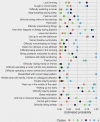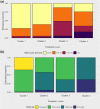Cancer sleep symptom-related phenotypic clustering differs across three cancer specific patient cohorts
- PMID: 35470503
- PMCID: PMC9788230
- DOI: 10.1111/jsr.13588
Cancer sleep symptom-related phenotypic clustering differs across three cancer specific patient cohorts
Abstract
Specific sleep disorders have been linked to disease progression in different cancers. We hypothesised sleep symptom clusters would differ between cancer types. The aim of this study was to compare sleep symptom clusters in post-treatment melanoma, breast and endometrial cancer patients. Data were collected from 124 breast cancer patients (1 male, 60 ± 15 years, 28.1 ± 6.6 kg/m2 ), 82 endometrial cancer patients (64.0 ± 12.5 years, 33.5 ± 10.4 kg/m2 ) and 112 melanoma patients (59 male, 65.0 ± 18.0 years, 29.1 ± 6.6 kg/m2 ). All patients completed validated questionnaires to assess sleep symptoms, including the Epworth Sleepiness Scale (ESS), Pittsburgh Sleep Quality Index (PSQI), Insomnia Severity Index (ISI), and Functional Outcomes of Sleep Questionnaire-10 (FOSQ-10). Snoring, tiredness, observed apneas, age, BMI, and gender data were also collected. Binary values (PSQI, ISI, FOSQ), or continuous variables for sleepiness (ESS) and perceived sleep quality (PSQI), were created and sleep symptom clusters were identified and compared across cancer cohorts. Four distinct sleep symptom clusters were identified: minimally symptomatic (n = 152, 47.7%); insomnia-predominant (n = 87, 24.9%); very sleepy with upper airway symptoms (n = 51, 16.3%), and severely symptomatic with severe dysfunction (n = 34, 11.1%). Breast cancer patients were significantly more likely to be in the insomnia predominant or severely symptomatic with severe dysfunction clusters, whereas melanoma patients were more likely to be minimally symptomatic or sleepy with upper airway symptoms (p <0.0001). Endometrial cancer patients were equally distributed across symptom clusters. Sleep symptom clusters vary across cancer patients. A more personalised approach to the management of sleep-related symptoms in these patients may improve the long term quality of life and survival.
Keywords: breast cancer; endometrial cancer; melanoma; sleep symptom clusters.
© 2022 The Authors. Journal of Sleep Research published by John Wiley & Sons Ltd on behalf of European Sleep Research Society.
Conflict of interest statement
No authors have any conflict of interest to declare.
Figures





Similar articles
-
Measures of sleep in rheumatologic diseases: Epworth Sleepiness Scale (ESS), Functional Outcome of Sleep Questionnaire (FOSQ), Insomnia Severity Index (ISI), and Pittsburgh Sleep Quality Index (PSQI).Arthritis Care Res (Hoboken). 2011 Nov;63 Suppl 11(0 11):S287-96. doi: 10.1002/acr.20544. Arthritis Care Res (Hoboken). 2011. PMID: 22588751 Free PMC article. Review. No abstract available.
-
Gastroesophageal reflux disease as an etiology of sleep disturbance in subjects with insomnia and minimal reflux symptoms: a pilot study of prevalence and response to therapy.Dig Dis Sci. 2008 Jun;53(6):1493-9. doi: 10.1007/s10620-007-0057-1. Dig Dis Sci. 2008. PMID: 17985241
-
The Usefulness of the Athens Insomnia Scale for Evaluating Sleep Disturbance in Patients with Chronic Liver Disease Comparing with Pittsburgh Sleep Quality Index and Epworth Sleepiness Scale.Medicina (Kaunas). 2022 May 30;58(6):741. doi: 10.3390/medicina58060741. Medicina (Kaunas). 2022. PMID: 35744004 Free PMC article.
-
Characterization of Patients Who Present With Insomnia: Is There Room for a Symptom Cluster-Based Approach?J Clin Sleep Med. 2017 Jul 15;13(7):911-921. doi: 10.5664/jcsm.6666. J Clin Sleep Med. 2017. PMID: 28633722 Free PMC article.
-
Pressure modification or humidification for improving usage of continuous positive airway pressure machines in adults with obstructive sleep apnoea.Cochrane Database Syst Rev. 2019 Dec 2;12(12):CD003531. doi: 10.1002/14651858.CD003531.pub4. Cochrane Database Syst Rev. 2019. PMID: 31792939 Free PMC article.
Cited by
-
Follow-up assessment of sleep-related symptoms in patients after treatment for cancer: responses to continuous positive airway pressure treatment for co-morbid obstructive sleep apnoea.Sleep Breath. 2024 May;28(2):725-733. doi: 10.1007/s11325-023-02946-6. Epub 2023 Dec 5. Sleep Breath. 2024. PMID: 38051468
-
Screening for obstructive sleep apnoea in post-treatment cancer patients.Cancer Rep (Hoboken). 2023 Mar;6(3):e1740. doi: 10.1002/cnr2.1740. Epub 2022 Dec 13. Cancer Rep (Hoboken). 2023. PMID: 36512174 Free PMC article.
-
Supporting gut health with medicinal cannabis in people with advanced cancer: potential benefits and challenges.Br J Cancer. 2024 Jan;130(1):19-30. doi: 10.1038/s41416-023-02466-w. Epub 2023 Oct 26. Br J Cancer. 2024. PMID: 37884682 Free PMC article. Review.
-
Study on the Profiles of Sleep Disorders, Associated Factors, and Pathways Among Gynecological Cancer Patients - A Latent Profile Analysis.Nat Sci Sleep. 2024 May 29;16:599-611. doi: 10.2147/NSS.S457651. eCollection 2024. Nat Sci Sleep. 2024. PMID: 38827390 Free PMC article.
References
-
- American Academy of Sleep Medicine . (2014). International classification of sleep disorders (3rd Edition ed.). American Academy of Sleep Medicine. - PubMed
-
- Anttalainen, U. , Grote, L. , Fietze, I. , Riha, R. L. , Ryan, S. , Staats, R. , … Collaborators, E. S. (2019). Insomnia symptoms combined with nocturnal hypoxia associate with cardiovascular comorbidity in the European sleep apnea cohort (ESADA). Sleep & Breathing, 23(3), 805–814. 10.1007/s11325-018-1757-9 - DOI - PMC - PubMed
Publication types
MeSH terms
LinkOut - more resources
Full Text Sources
Medical

